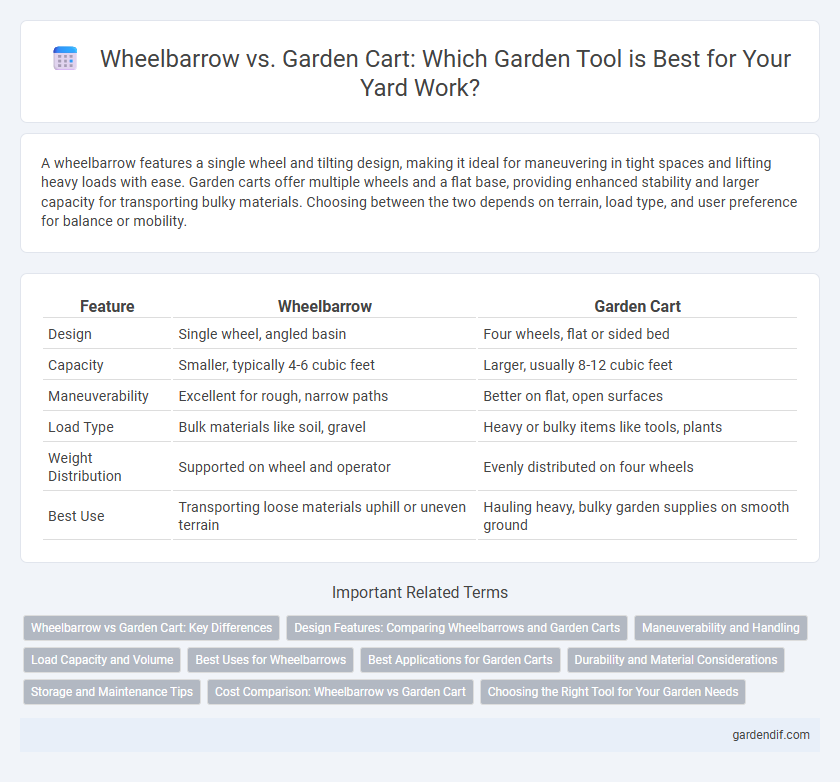
Wheelbarrow vs Garden cart Illustration
A wheelbarrow features a single wheel and tilting design, making it ideal for maneuvering in tight spaces and lifting heavy loads with ease. Garden carts offer multiple wheels and a flat base, providing enhanced stability and larger capacity for transporting bulky materials. Choosing between the two depends on terrain, load type, and user preference for balance or mobility.
Table of Comparison
| Feature | Wheelbarrow | Garden Cart |
|---|---|---|
| Design | Single wheel, angled basin | Four wheels, flat or sided bed |
| Capacity | Smaller, typically 4-6 cubic feet | Larger, usually 8-12 cubic feet |
| Maneuverability | Excellent for rough, narrow paths | Better on flat, open surfaces |
| Load Type | Bulk materials like soil, gravel | Heavy or bulky items like tools, plants |
| Weight Distribution | Supported on wheel and operator | Evenly distributed on four wheels |
| Best Use | Transporting loose materials uphill or uneven terrain | Hauling heavy, bulky garden supplies on smooth ground |
Wheelbarrow vs Garden Cart: Key Differences
Wheelbarrows feature a single wheel and a deep, narrow tray designed for carrying heavy loads over uneven terrain, offering better maneuverability. Garden carts typically have four wheels and a wider, shallow bed, providing greater stability and capacity for transporting bulkier materials. Choosing between a wheelbarrow and a garden cart depends on specific tasks, terrain type, and load requirements, with wheelbarrows suited for tight spaces and rough paths, while garden carts excel in flat, open areas.
Design Features: Comparing Wheelbarrows and Garden Carts
Wheelbarrows feature a single front wheel and two handles, allowing for easy maneuverability in tight garden spaces and uneven terrain, while garden carts typically have four wheels and a flatbed design for enhanced stability and larger load capacity. The wheelbarrow's deep basin design is ideal for carrying soil, debris, or plants, whereas garden carts often come with side panels and convertible beds for versatile hauling of bulkier items. Ergonomic handlebars and balanced weight distribution in wheelbarrows reduce user strain during tipping, while garden carts prioritize ease of load dumping and extended hauling comfort.
Maneuverability and Handling
Wheelbarrows feature a single wheel design, allowing for agile maneuverability in tight garden spaces and uneven terrain, but require balance and strength to operate effectively. Garden carts typically have multiple wheels, providing enhanced stability and easier handling when transporting heavy loads over flat surfaces, though they may be less nimble in confined areas. Choosing between a wheelbarrow and a garden cart depends largely on the terrain and the nature of the tasks, with wheelbarrows excelling in narrow, irregular paths and garden carts favoring spacious, level ground.
Load Capacity and Volume
Wheelbarrows typically offer a load capacity ranging from 100 to 150 pounds with a volume of 4 to 6 cubic feet, suitable for transporting soil, mulch, and heavy materials in tight spaces. Garden carts often provide a higher load capacity, between 200 to 300 pounds, and larger volume capacity around 8 to 12 cubic feet, making them ideal for bulky, lightweight materials and gardening supplies. Selecting between a wheelbarrow and garden cart depends on the balance needed between maneuverability for heavy loads and volume for carrying larger, less dense items.
Best Uses for Wheelbarrows
Wheelbarrows are ideal for transporting heavy or uneven loads, such as soil, mulch, rocks, and construction materials, across rough terrain or confined spaces. Their single-wheel design provides excellent maneuverability and precision when navigating tight garden paths or steep inclines. Garden carts, in contrast, excel at carrying large, balanced loads but lack the versatility and agility needed for rugged or uneven surfaces.
Best Applications for Garden Carts
Garden carts excel in transporting heavy loads such as mulch, soil, and plants across uneven terrain, making them ideal for landscaping projects and garden maintenance. Their flat, spacious beds accommodate bulky items and tools better than wheelbarrows, enhancing efficiency during large-scale gardening tasks. Designed for stability, garden carts reduce strain and improve maneuverability, especially when moving delicate or irregularly shaped garden supplies.
Durability and Material Considerations
Wheelbarrows typically feature a single steel or plastic wheel and a robust steel frame that offers superior durability on rough terrain, making them ideal for heavy-duty gardening tasks. Garden carts often use four wheels and may incorporate aluminum or heavy-duty plastic materials, which provide a balance of lightweight maneuverability and rust-resistance, though they may lack the toughness of steel in rugged use. Choosing between a wheelbarrow and a garden cart depends on the intended workload and environmental conditions, emphasizing the importance of material composition and structural durability.
Storage and Maintenance Tips
Wheelbarrows require regular cleaning to prevent rust and wheel deformation, with grease applied to the wheel axle for smooth operation, while garden carts need periodic tire pressure checks and hose down to remove soil buildup. Storage in a dry, covered area prolongs the lifespan of both tools by protecting metal parts from moisture and wooden handles from cracking. Using protective covers and lubricating moving parts reduces wear and simplifies maintenance for wheelbarrows and garden carts alike.
Cost Comparison: Wheelbarrow vs Garden Cart
Wheelbarrows typically cost between $50 and $150, making them a budget-friendly option for basic gardening tasks, whereas garden carts range from $100 to $300 due to their larger capacity and enhanced durability. The price difference reflects the materials used, with wheelbarrows often constructed from lighter metal or plastic and garden carts featuring heavy-duty steel frames and pneumatic tires. For those prioritizing long-term investment and versatility, garden carts offer greater value despite the higher initial cost.
Choosing the Right Tool for Your Garden Needs
Selecting between a wheelbarrow and a garden cart depends on the type and volume of garden materials to be moved; wheelbarrows excel in transporting heavy, uneven loads over rough terrain due to their single-wheel design, offering enhanced maneuverability. Conversely, garden carts feature multiple wheels and a larger, stable bed, making them ideal for hauling bulky, lighter items such as soil, mulch, and plants across flat surfaces. Evaluating factors like load capacity, stability, terrain type, and ease of use ensures choosing the right tool maximizes efficiency and comfort in garden maintenance tasks.
Wheelbarrow vs Garden cart Infographic

 gardendif.com
gardendif.com